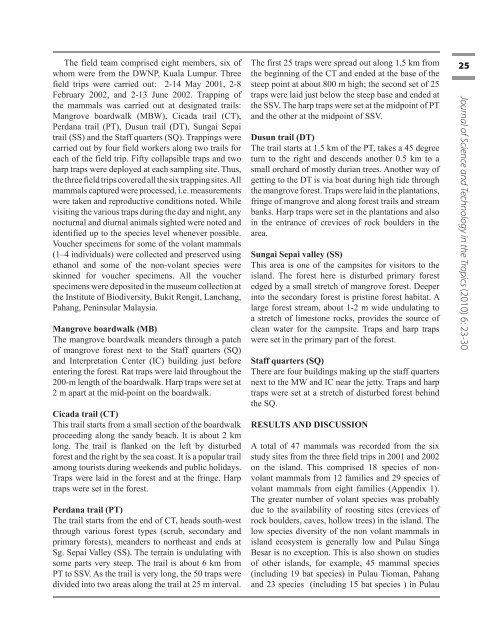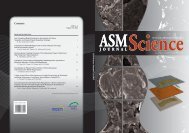Download - Akademi Sains Malaysia
Download - Akademi Sains Malaysia
Download - Akademi Sains Malaysia
You also want an ePaper? Increase the reach of your titles
YUMPU automatically turns print PDFs into web optimized ePapers that Google loves.
The field team comprised eight members, six of<br />
whom were from the DWNP, Kuala Lumpur. Three<br />
field trips were carried out: 2-14 May 2001, 2-8<br />
February 2002, and 2-13 June 2002. Trapping of<br />
the mammals was carried out at designated trails:<br />
Mangrove boardwalk (MBW), Cicada trail (CT),<br />
Perdana trail (PT), Dusun trail (DT), Sungai Sepai<br />
trail (SS) and the Staff quarters (SQ). Trappings were<br />
carried out by four field workers along two trails for<br />
each of the field trip. Fifty collapsible traps and two<br />
harp traps were deployed at each sampling site. Thus,<br />
the three field trips covered all the six trapping sites. All<br />
mammals captured were processed, i.e. measurements<br />
were taken and reproductive conditions noted. While<br />
visiting the various traps during the day and night, any<br />
nocturnal and diurnal animals sighted were noted and<br />
identified up to the species level whenever possible.<br />
Voucher specimens for some of the volant mammals<br />
(1–4 individuals) were collected and preserved using<br />
ethanol and some of the non-volant species were<br />
skinned for voucher specimens. All the voucher<br />
specimens were deposited in the museum collection at<br />
the Institute of Biodiversity, Bukit Rengit, Lanchang,<br />
Pahang, Peninsular <strong>Malaysia</strong>.<br />
Mangrove boardwalk (MB)<br />
The mangrove boardwalk meanders through a patch<br />
of mangrove forest next to the Staff quarters (SQ)<br />
and Interpretation Center (IC) building just before<br />
entering the forest. Rat traps were laid throughout the<br />
200-m length of the boardwalk. Harp traps were set at<br />
2 m apart at the mid-point on the boardwalk.<br />
Cicada trail (CT)<br />
This trail starts from a small section of the boardwalk<br />
proceeding along the sandy beach. It is about 2 km<br />
long. The trail is flanked on the left by disturbed<br />
forest and the right by the sea coast. It is a popular trail<br />
among tourists during weekends and public holidays.<br />
Traps were laid in the forest and at the fringe. Harp<br />
traps were set in the forest.<br />
Perdana trail (PT)<br />
The trail starts from the end of CT, heads south-west<br />
through various forest types (scrub, secondary and<br />
primary forests), meanders to northeast and ends at<br />
Sg. Sepai Valley (SS). The terrain is undulating with<br />
some parts very steep. The trail is about 6 km from<br />
PT to SSV. As the trail is very long, the 50 traps were<br />
divided into two areas along the trail at 25 m interval.<br />
The first 25 traps were spread out along 1.5 km from<br />
the beginning of the CT and ended at the base of the<br />
steep point at about 800 m high; the second set of 25<br />
traps were laid just below the steep base and ended at<br />
the SSV. The harp traps were set at the midpoint of PT<br />
and the other at the midpoint of SSV.<br />
Dusun trail (DT)<br />
The trail starts at 1.5 km of the PT, takes a 45 degree<br />
turn to the right and descends another 0.5 km to a<br />
small orchard of mostly durian trees. Another way of<br />
getting to the DT is via boat during high tide through<br />
the mangrove forest. Traps were laid in the plantations,<br />
fringe of mangrove and along forest trails and stream<br />
banks. Harp traps were set in the plantations and also<br />
in the entrance of crevices of rock boulders in the<br />
area.<br />
Sungai Sepai valley (SS)<br />
This area is one of the campsites for visitors to the<br />
island. The forest here is disturbed primary forest<br />
edged by a small stretch of mangrove forest. Deeper<br />
into the secondary forest is pristine forest habitat. A<br />
large forest stream, about 1-2 m wide undulating to<br />
a stretch of limestone rocks, provides the source of<br />
clean water for the campsite. Traps and harp traps<br />
were set in the primary part of the forest.<br />
Staff quarters (SQ)<br />
There are four buildings making up the staff quarters<br />
next to the MW and IC near the jetty. Traps and harp<br />
traps were set at a stretch of disturbed forest behind<br />
the SQ.<br />
RESULTS AND DISCUSSION<br />
A total of 47 mammals was recorded from the six<br />
study sites from the three field trips in 2001 and 2002<br />
on the island. This comprised 18 species of nonvolant<br />
mammals from 12 families and 29 species of<br />
volant mammals from eight families (Appendix 1).<br />
The greater number of volant species was probably<br />
due to the availability of roosting sites (crevices of<br />
rock boulders, caves, hollow trees) in the island. The<br />
low species diversity of the non volant mammals in<br />
island ecosystem is generally low and Pulau Singa<br />
Besar is no exception. This is also shown on studies<br />
of other islands, for example, 45 mammal species<br />
(including 19 bat species) in Pulau Tioman, Pahang<br />
and 23 species (including 15 bat species ) in Pulau<br />
Jostt vol 6.indd 25 7/22/10 10:09:02 PM<br />
25<br />
Journal of Science and Technology in the Tropics (2010) 6: 23-30

















